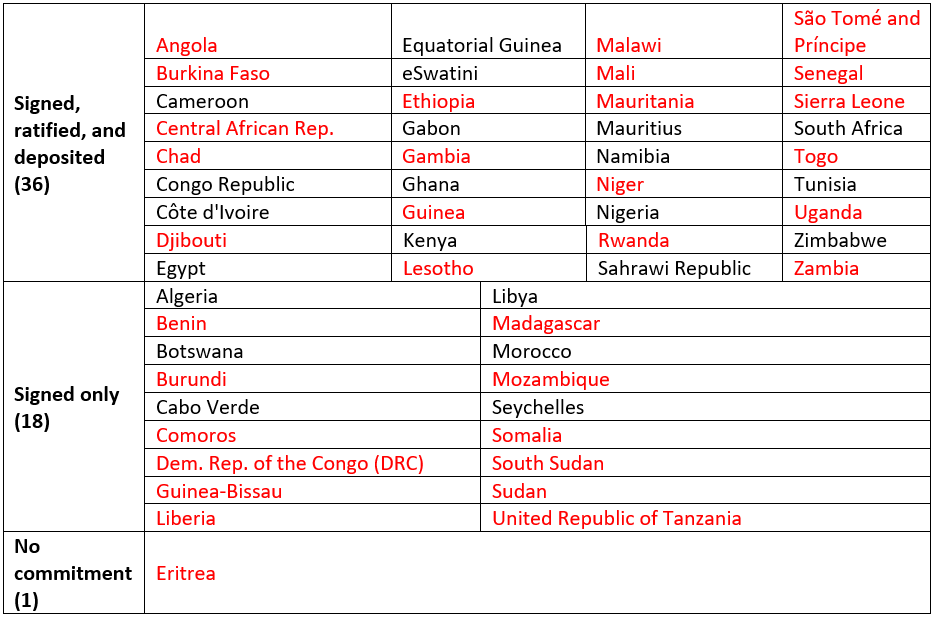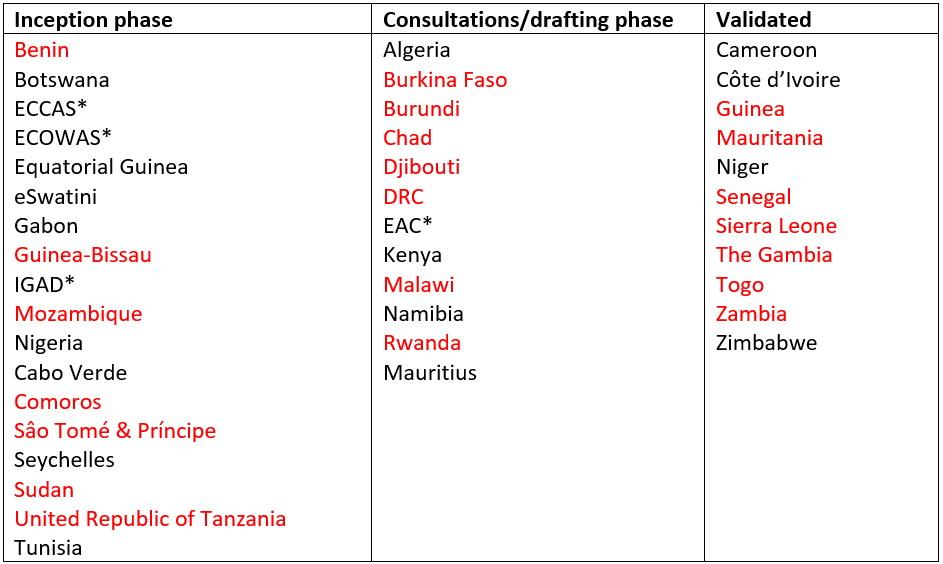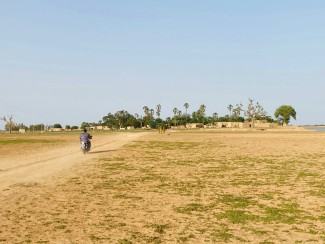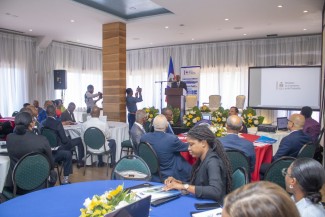New trade agreement involves country and regional economic community actions
On 1 January 2021, Africa officially started trading under the African Continental Free Trade Area (AfCFTA) Agreement.
As of February, 54 of the 55 African Union Member States have signed on. Thirty-six countries (including 19 African least developed countries, or LDCs) have deposited their instruments of ratification, confirming them as State Parties to the agreement (see Table 1). As with many trade agreements, signing then ratification is a prerequisite to enjoying any benefits.
Table 1: Status of AfCFTA ratification

Source: African Union Commission (AUC)
*Countries in red are LDCs
Trade under the AfCFTA means a liberalized single market for goods and services facilitated by the easy movement of people and capital. It also lays the foundation for a continent-wide customs union. Ultimately, this new single market is expected to contribute to sustainable and inclusive socioeconomic development, gender equality and, more broadly, enhanced competitiveness and industrial development.
African countries that ratify the agreement consent to liberalize 90% of tariff lines. This means that countries will reduce, and ultimately eliminate, tariffs on 90% of products traded under the AfCFTA. LDCs are expected to accomplish this over a 10-year period, and non-LDCs over a five-year period. Sensitive products, of up to 7% of tariff lines, will be fully liberalized over 13 years for LDCs and 10 years for non-LDCs. Finally, 3% of tariff lines will be excluded from tariff liberalization.
The Agreement allows special treatment for LDCs with longer implementation periods. However, to maintain a common external tariff, both LDCs and non-LDCs in a customs union must apply the same timeframes for implementation.
There are five additional instruments that will support AfCFTA operationalization. These are: 1) rules of origin, which ensure that products traded within the market actually originate from within the continent and are therefore subject to tariff preferences; 2) an online portal for tariff negotiations, which facilitates discussions between states, customs unions and regional groupings on tariff liberalization; 3) an online mechanism for monitoring, reporting and elimination of non-tariff barriers (NTBs); 4) a pan-African payment and settlement system, which makes it possible for African companies to clear and settle intra-African trade transactions in their local currencies; and 5) the African Trade Observatory, which will provide stakeholders up-to-date and reliable trade data, as well as information about exporters and importers in countries.
National and regional strategies
The United Nations Economic Commission for Africa (ECA) is playing a key role in providing support to the AfCFTA process. ECA is collaborating with the African Union Commission (AUC) and various partners to advocate for AU Member States' AfCFTA ratification and implementation, sensitization around the AfCFTA and technical support to the negotiations. The technical support includes help with the preparation of negotiating texts and liberalization modalities, and assistance in developing tariff offers for the East African Community (EAC) and Economic Community of Central African States.
ECA’s technical support also extends to assistance in the preparation of national AfCFTA strategies. Forty-one countries, including 21 LDCs and four Regional Economic Communities (RECs) (see Table 2), are at various stages in preparing these strategies, which identify strategic areas of national interest and relevant interventions to ensure that countries and regions fully participate and benefit from the agreement.
So far, 11 of the 41 countries and RECs have validated AfCFTA implementation strategies. The strategies aim at complementing the broader development framework of each country or region, especially in relation to trade and industrialization policies. Some are already implementing their AfCFTA strategies and have a National Committee in place to ensure proper coordination of implementation, policy coherence and effective domestication of the agreement.
In Côte d'Ivoire for example, the government has released the AfCFTA National Committee budget to implement priority actions of the AfCFTA national strategy, and in September 2020, its committee trained 200 owners and operators of SMEs in four cities on the use of the continental online tool for monitoring, reporting and elimination of NTBs. Togo held a training for customs authorities and affiliated institutions to improve their knowledge of the AfCFTA. Sierra Leone is developing an industrial policy and special economic zones policy to create a conducive environment for the industrial sector to grow and contribute to the diversification of the economy.
Table 2: Status of AfCFTA implementation strategies

*Countries in red are LDCs
** denotes RECs
COVID-19 impacts
Cognizant of the disruptions and toll COVID-19 has taken on business operations and trade flows across the world, countries are including COVID-19 analyses and mitigation measures into their AfCFTA strategies.
Sierra Leone, for example, under the pillar of trade support, has included actions around COVID-19 mitigation to improve access to essential COVID-19 medical supplies, protect its trade and foreign exchange earnings from the adverse impacts of COVID-19 restrictions, and ensure safe trade.
The AfCFTA itself includes provisions on NTBs, trade facilitation and customs cooperation that can be utilized to ensure that trade is conducted safely. Indeed, ECA and the African Union have developed guidelines on COVID-19 trade and transport based on best practices on border regulations being implemented by RECs.[1] The guidelines work to ensure uniform regulations, procedures and standards are in place to reduce the coronavirus spread and minimize disruptions in supply chains, and facilitate the movement of goods and services within the continent during the pandemic.
COVID-19 has exposed the vulnerability of African countries in their dependence on trading partners in the rest of the world, with countries mostly importing essential items such as food, pharmaceutical products, fuel, machinery and other goods. According to UNECA, African countries import 94% of their medical and pharmaceutical products from outside the continent. Successful implementation of the AfCFTA could support the development of competitive and resilient regional value chains and increase domestic and regional industrialization, including in the health sector.
What to do with new trade across borders
As of February, 41 State Parties had submitted their schedules of tariff concessions, including customs unions members from the Central African Economic and Monetary Community, the Southern Africa Customs Union, the EAC and the Economic Community of West African States. However, not all customs processes are fully in place. Only a few countries, such as Cameroon, Egypt, Ghana and South Africa, have in place the needed customs procedures as required by the relevant AfCFTA provisions.
Nonetheless, businesses have started to respond to the AfCFTA market: Ethiopian Airlines, DHL and the African Electronic Trade Group partnered to ship the first goods under the AfCFTA. On 1 January 2021, the African Electronic Trade Group transported goods produced in eSwatini to various countries that had signed and ratified the AfCFTA, including South Africa and Ethiopia. According to the AfCFTA Secretariat, on 4 January, a shipment of beverage and cosmetic products under the AfCFTA documents and rules took place from Ghana to South Africa and Guinea.
There remain, however, outstanding negotiations that must be finalized in order for the AfCFTA to fully take off, so to speak. This includes finalization of the schedules of specific commitments of trade in services in the five priority services sectors of business, communications, finance, tourism and transport. For trade in goods, there remain negotiations on rules of origin and the remaining tariff offers.
More importantly, it is even more urgent that countries that are part of a customs union but have not yet ratified the AfCFTA do so, in order to ensure coherence in trading under the AfCFTA into the future.
[1] United Nations Economic Commission for Africa, African Union Commission (2021). Continental Guidelines On Trade And Transport Facilitation For The Movement Of Persons, Goods And Services Across Africa During The COVID-19 Pandemic, ECA, February 2021
This piece is part of a dedicated series to spur dialogue, conversations, and debate alongside the WTO's Aid for Trade Stocktaking event taking place from 23 to 25 March. The piece responds to the event's Theme 7: Regional approaches to COVID-19 recovery.
If you would like to reuse any material published here, please let us know by sending an email to EIF Communications: eifcommunications@wto.org.



